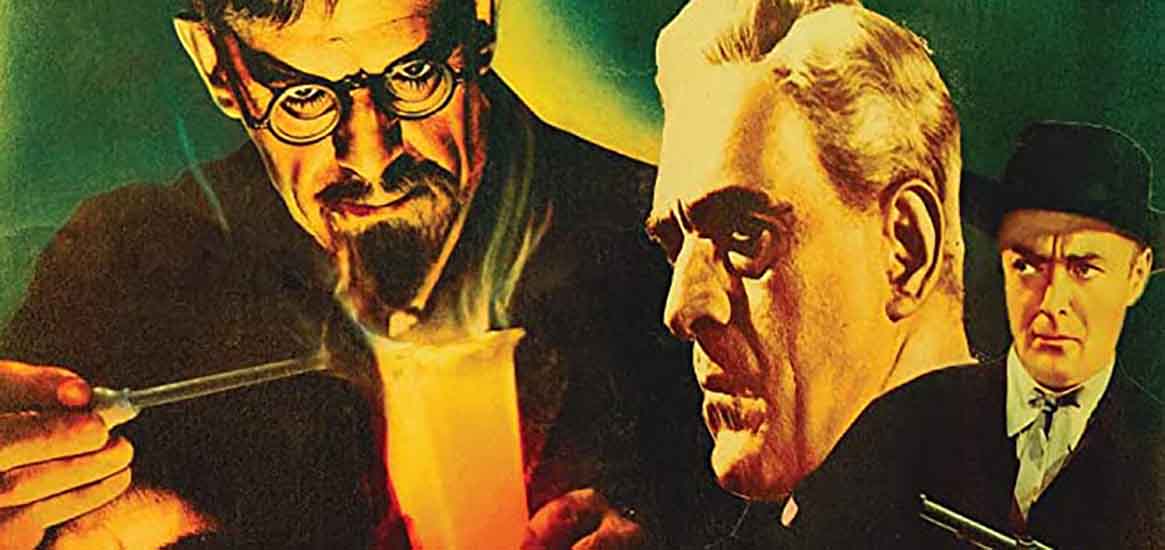The Black Room / The Man They Could Not Hang / Before I Hang / The Man With Nine Lives / The Devil Commands / The Boogie Man Will Get You / The Return of the Vampire / Five
BLU-RAY STREET DATE: FEBRUARY 21, 2023/MILL CREEK ENTERTAINMENT
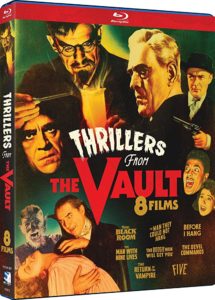
Bringing a whopping eight vintage titles together from the Columbia Pictures back-catalog is Mill Creek’s Thrillers from the Vault release. Compromised of four Blu-ray discs, each containing two movies (housed in the case in two stacks of two), the set also has four audio commentaries on four separate films with film historians and even an original thirty-six-minute documentary called Madness and Mayhem: Horror in the 30s and 40s, with film historian and filmmaker C. Courtney Joyner.
Though Thrillers from the Vault is not at all perfect across the board in the A/V department, the majority of the individual titles look and sound above average if not better. Below, each of the eight films is individually spotlighted. Any particular A/V concerns, if there are any, are reported on a per-film basis. Like it’s rather inferior and half-sized sister release, Sci-fi from the Vault, Thrillers from the Vault comes packaged in a dynamically illustrated slipcover representing all the films. It’s quite cool looking.
Of particular note to classic horror fans, this set contains not only the whole of Arsenic and Old Lace superstar Boris Karloff’s unofficial series of “Mad Doctor” films (The Man They Could Not Hang, The Man With Nine Lives, Before I Hang and The Devil Commands), but also an astonishingly good gothic stand-alone precursor (The Black Room) and a horror-comedy (The Boogie Man Will Get You, costarring Peter Lorre). Rounding out the set are a few non-Karloff titles, the Bela Lugosi-starring Return of the Vampire and the global annihilation drama, Five. At least three of these movies are must-owns for any fan of classic horror. But who are we kidding? Such fans will want to have them all on their shelves! Here’s how they stack up…
The Black Room
DIRECTED BY ROY WILLIAM NEILL/1935
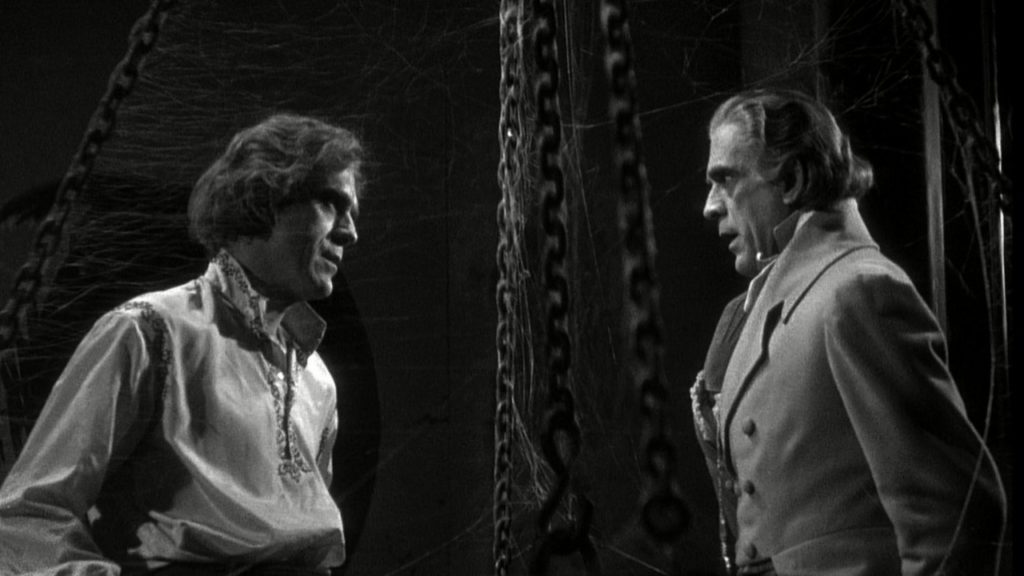
In this eight-film set dominated by Boris Karloff, 1935’s The Black Room takes things a step further by featuring TWO Boris Karloffs! Yes, the man who rose to fame as Frankenstein’s monster serves in dual roles here, playing aristocratic twin brothers Baron Gregor de Berghman and Anton de Berghman.
Directed by Roy William Neill, it’s immediately apparent that The Black Room is a technically astonishing film- and that’s before we even get to the myriad of scenes in which the dueling Karloffs act against one another. It’s not just one or two short moments that the twin Karloffs share the screen- its large portions of the film. Neill demonstrates the most cleverly meticulous workarounds and solutions in creating these scenes, and his star is fully onboard.
It’s 1834. A scary old prophesy says that the younger brother will murder the older brother… in the Black Room! Despite precautions of the previous generation and their attempt to brick over the entrance of that particular chamber in the castle, a back entrance is found. But, not by whom it’s been foretold. The younger Gregor, looking to subvert fate, plots to do away with Anton, and steal his identity, and thus, his regal standing.
As conniving and methodical as Gregor is, it’s only fitting that his brother’s dog proves to be the greatest thorn in his side. In the ever-striking The Black Room, stunning performance(s) by Karloff and beautiful direction by Neill culminate in the service of a thoroughly remarkable picture. It also stars Marian Marsh and Robert Allen, though the film’s biggest draw was and will remain the ease of which Karloff acts beside himself as two incredibly distinctive characters.
Dr. Steve Haberman delivers one of the finest audio commentaries I’ve heard in quite some time, connecting Jungian philosophies, Christian scripture, and plenty of related facts about Karloff, Neill, and the masterpiece that is The Black Room itself. The film is beautifully crafted and entirely compelling- the perfect “double feature” to begin Thrillers from the Vault.
The Man They Could Not Hang
DIRECTED BY NICK GRINDE/1939
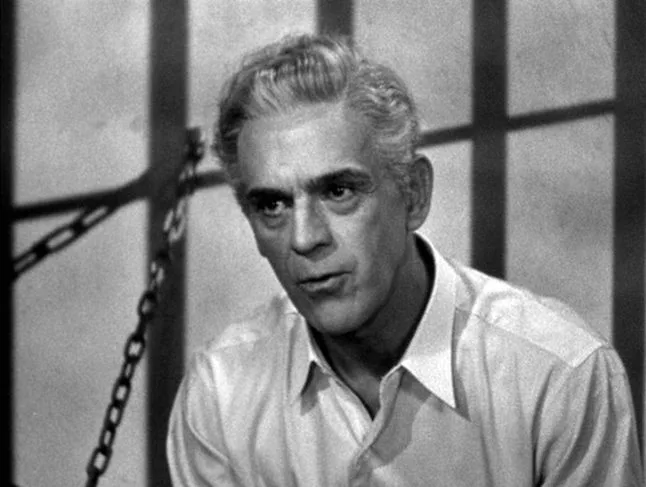
Clocking in at an overly efficient sixty-four minutes is 1939’s The Man They Could Not Hang, Thillers from the Vault’s first of three collaborations between Karloff and director Nick Grinde. While it’s true that you’ll rarely meet a film critic who doesn’t espouse honest appreciation when a film knows how to be brief, it can’t be said that this film would properly qualify. It’s as though there was an edict to keep this movie under sixty-five minutes, or else!!Consequently, key moments in the narrative are skipped, the remaining potholes paved over with tacky, rushed expository dialogue. “You killed HIM?!? Oh, my!” Thankfully, Karloff is excellent, and impressively carries the full weight of this haphazard nonsense.
The story finds Karloff, playing an audacious and brilliant heart surgeon, tampering in God’s domain. His attempt to restore life to a recently deceased student athlete- voluntarily killed by Karloff in order to be brought back better- would’ve likely ended with a breakthrough medically induced resurrection, had his nurse not panicked and reported the experiment, while in progress, to the police. So, instead of making history, the good doctor finds himself making time in court. Then prison. Then the hangman’s noose. He’s dead. End of Act I.
Act II finds Karloff’s character back from the dead and carrying a serious grudge. Act III culminates with him gathering all of the people he blames for everything having gone so wrong for him, and then exacting ghoulish revenge upon them. And what revenge it is…! It’s all so impossibly meticulous, with everyone’s reactions to everything fully and properly anticipated. They may’ve hung The Man They Could Not Hang, but his vengeance leaves no one hung out to dry. This movie is as irritating in its own internal logic as it it memorable.
The Man They Could Not Hang gets another of the Thrillers from the Vault set’s four expert audio commentaries. This one is with film historian and filmmaker C. Courtney Joyner and Heath Holland of the Cereal at Midnight YouTube channel and podcast. The track gets off to a very awkward start with Holland plowing past Joyner’s first factoid to wonder about a supporting character’s Coke bottle glasses. Then they go quiet for minutes on end. When they finally do return, the chat gets on a better track. Both demonstrate a handy knowledge of Karloff and the state of Columbia Pictures at the time. Fascinating stuff that effectively enhances one’s viewings of this and its set-mates.
Before I Hang
DIRECTED BY NICK GRINDE/1940
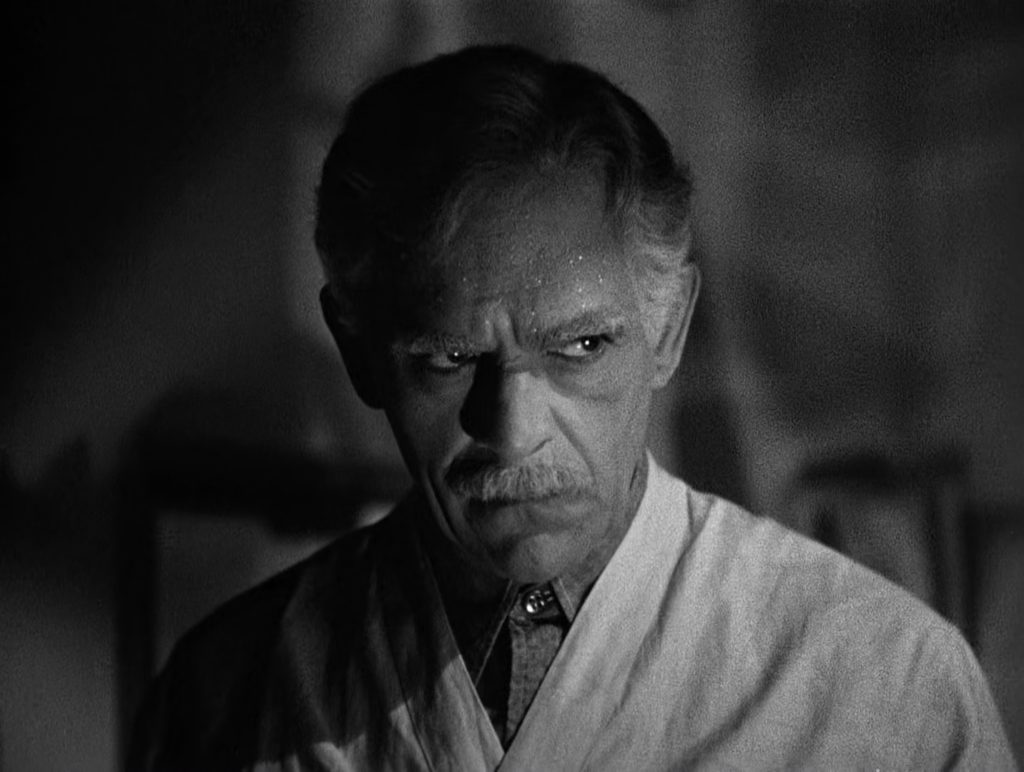
Once more but with even more feeling… Karloff and director Nick Grinde “hang” together once more following the entertaining but mixed bag that is The Man They Could Not Hang with a similar but superior “mad doctor” entry. Once again, we find an extremely sympathetic Karloff on trial for a patient’s death following a failed attempt to perfect a youth serum. This time, however, he’s already an old man, facing his own natural voyage into the fog of forever. The judge’s sentence that he be hung from the neck until dead ought to speed that up considerably, though.
With his final moments, the doctor spends them in his lab prepping himself for recovery from his capital punishment. But things go sideways when an unforeseen murderous impulse kicks in, no thanks to the “maniac’s blood” he injected himself with. Although Before I Hang succeeds in churning up wonderfully evocative gothic visuals on what we know to be Columbia’s unsupportive sparse budget, it must be said that, weirdly, the film’s shift into horror-thriller mode is where it somewhat weakens. While Karloff gives yet another outstanding performance, this one convincingly veering from old to less old and kindly to deathly, the screenplay’s reasonings for his turn to evil are wanting at best.
The transfer utilized by Mill Creek ranges from acceptable to very nice, with a very brief passage when it appears to lapse into a different, unrestored print. These things happen by necessity with old movies. There are no bonus features coupled with this film nor its disc-mate, 1940’s The Man with Nine Lives.
The Man With Nine Lives
DIRECTED BY NICK GRINDE/1940
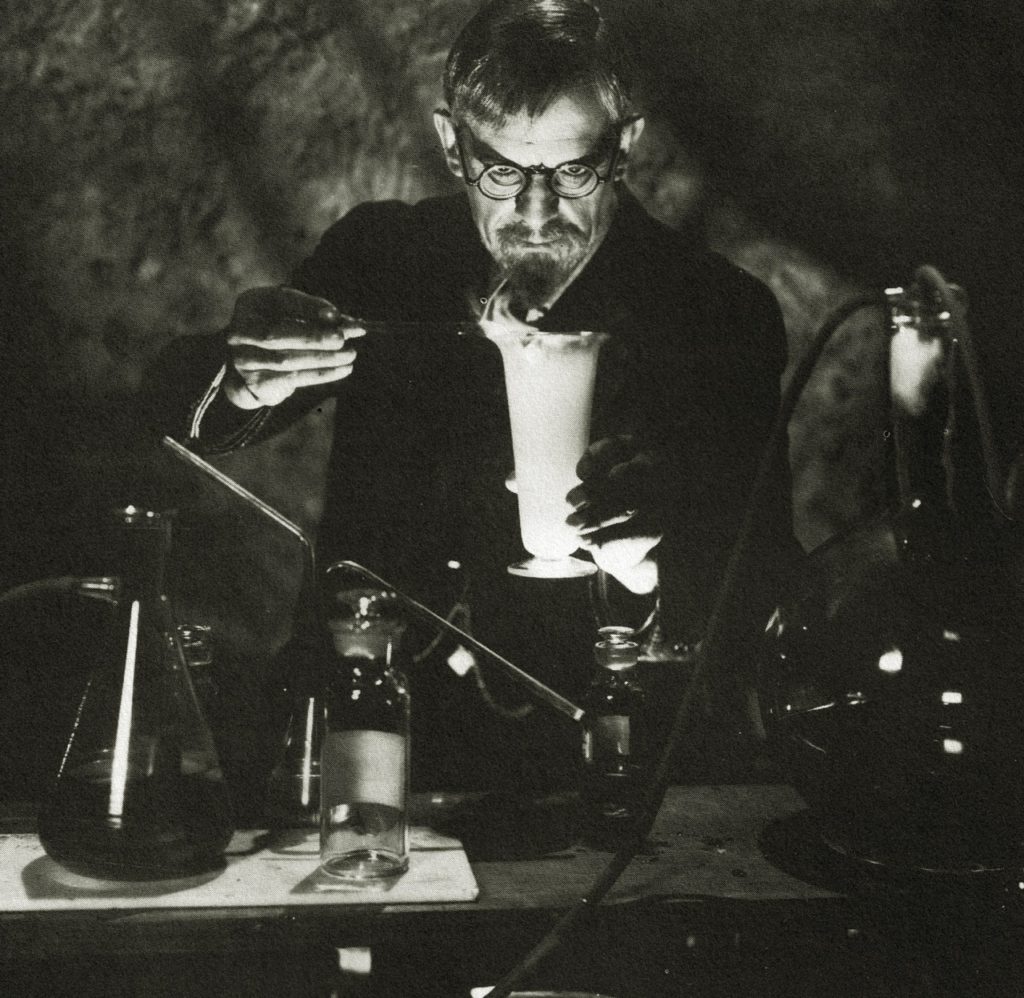
And again, Nick Grinde directs Boris Karloff as a brilliant medical scientist who’s cracked the secret of life and death but turns out to be completely psychopathic when it comes to defending his work. Karloff this time is looking to freeze cancer-stricken unconscious humans in suspended animation until such a time that a cure is available. No sooner does he succeed than he accidentally freezes himself! Oops!
Actually, that occurs off screen. We don’t meet Karloff until a fellow scientist and admirer played by “the poor man’s Clark Gable”, Roger Pryor, stumbles onto his frozen body, and, with the help of his devoted nurse companion (Jo Ann Sayers), revives him. Before long, however, Pryor learns the hard way that the old adage not meet your heroes is worth heeding.
Karloff’s been frozen for ten years- as has a group of oppositional doctors who believe he is mad. They too are thawed, only to be targeted anew by Karloff. If he can’t use them to test his theories, they’ll simply have to die, as not to endanger his precious work. Most of the movie takes place in the three connected chambers of the villain’s remote freezing lair. For this, The Man with Nine Lives has a very stagey feel about it. By this point in the Karloff’s Columbia run, the brilliant-but-crackpot scientist routine is starting to feel a bit long in the tooth, although one can’t claim that this is necessarily a bad movie, either. Why, however, it is called “The Man with Nine Lives” remains a mystery. There is nothing feline in sight… nor on ice.
The Devil Commands
DIRECTED BY EDWARD DMYTRYK/1941
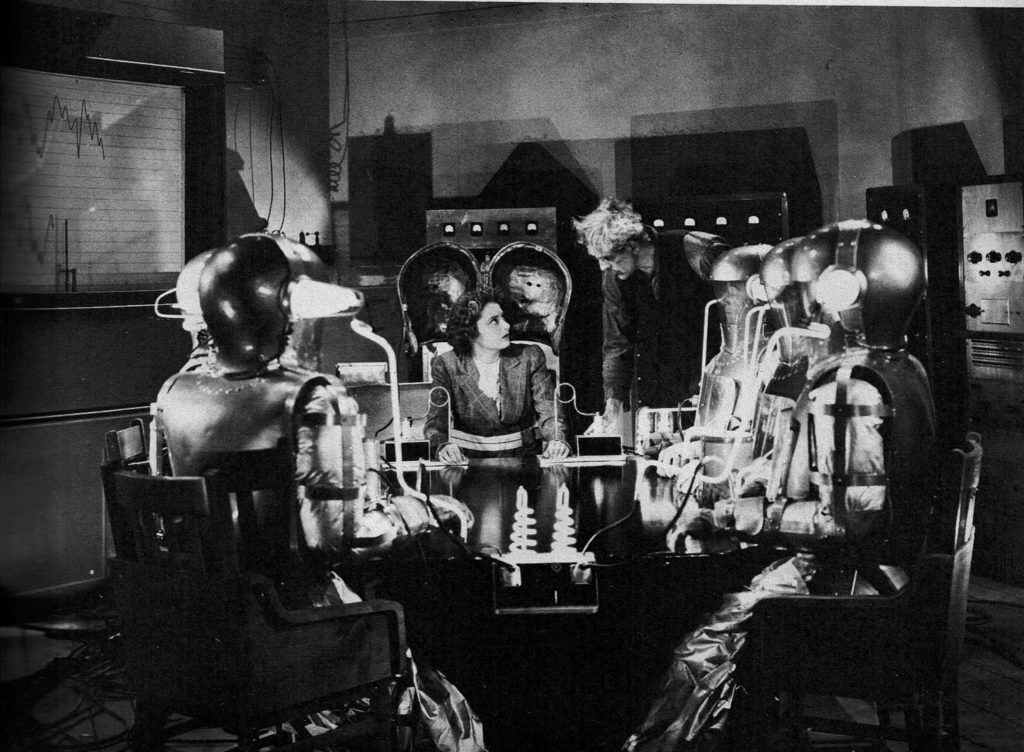
Just when I thought the Karloff/Mad Doctor formula has been exhausted, The Devil Commands my full attention! This later entry into Columbia’s series of Karloff overreaching scientist programmers almost subverts and improves upon its well-worn formula the way Punch-Drunk Love twists and tweaks the Adam Sandler comedies of the early 2000s while still being one. Future HUAC-targeted director Edward Dmytryk takes the baton from previous helmer Nick Grinde, and really runs with it. Karloff, being the consummate and versatile professional that he is, absolutely keeps up.
Dmytryk’s film, however, lacks the outward “freedom of absurdity” of the aforementioned Sandler outlier. Or does it? The creatives of The Devil Commands demonstrate a certain knowing embrace of the material’s inherent ridiculousness and opt to ride it out further rather than portend to reign it in or worse, validate it as some sort of-the-moment factual exploration. The film isn’t meant to be laughed at, but enjoyed as the thoroughly engaging descent into passionately distorted immortality that it is.
Adapted from William Sloane’s novel The Edge of Running Water, Karloff is Dr. Blair, another good-hearted obsessive scientist on the brink of a massive breakthrough. While experimenting with the uniqueness of brain activity in the deceased (the bodies are adorned in modified diving suits, for maximum strangeness), he discovers that his beloved late wife (Shirley Warde) is apparently able to contact him from beyond the grave via his apparatus. An icy and controlling Anne Revere plays the titular commanding “devil” of the story, a phony medium called Mrs. Walters. Walters leads Dr. Blair to New England, effectively isolating him from his community and his concerned daughter (Amanda Duff). In this locale, however, things do not get any better.
The film’s transfer is appropriately striking, in keeping with most of its set-mates. This title is one of the four that netted a new audio commentary, this time by “monster kid” film historian Tom Weaver. Like Weaver’s usual commentaries, it’s extremely well researched (as he commonly lets us know his processes), quite punchy, and featuring guest voices and re-enactments from old interviews he conducted years ago. The biggest “get” that Weaver utilizes is his past interview with Dmytryk himself, who openly discusses what it was like to be contracted as a B-movie director for a studio like Columbia. The Lost Skeleton of Cadavra filmmaker Larry Blamire deserves commentator credit as well, as he not only performs voices but shares his own appreciation of the Karloff “mad doctor” films. Weaver was kind enough to make Blamire’s most glowing appreciation the track’s closing words. Save for a cringe-inducing references by Weaver to people cowering in fear of “the China virus” (not Weaver’s first time to toss in such a pandemic-related aside on a recent commentary), this is an all-around excellent track.
Deftly executed and thoroughly engaging, The Devil’s Command demonstrates what a great director can do with a great lead, a good cast, and little else. It is without question one of the standout films in Mill Creek’s eight-film Thrillers from the Vault set.
The Boogie Man Will Get You
DIRECTED BY LEW LANDERS/1942
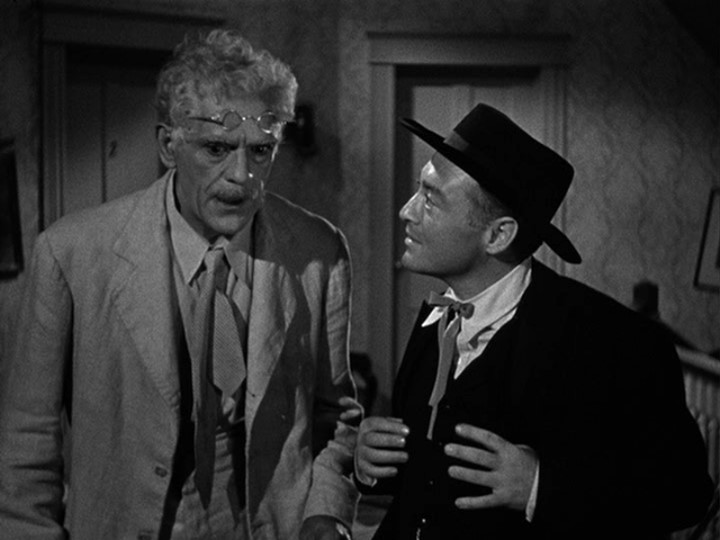
Riding the trend of comedy-horror movies so prevalent at the time is 1942’s The Boogie Man Will Get You. Once again, Boris Karloff plays an eccentric scientist hung up on his experiments. This time, he’s Professor Billings, a dithering old man in a white lab coat trying to create super-powered soldiers for the war effort. This involves keeping several dead bodies around, which raise some red flags once he sells the property. (The Professor, faced with mortgage debts, sells the property to a gullible young idealist played by actress Jeff Donnell- but he and his housekeeper are still allowed to live there). That’s just the first of many odd choices made by characters throughout this noisy cockatoo of a movie.
As directed by Lew Landers, The Boogie Man Will Get You is obviously crafted in the George S. Kaufman & Moss Hart (You Can’t Take It with You) theatrical style of contained chaos via colorful characters. This movie, though, is a busy chatterbox of an experience where everyone seems to be zany for zaniness’ sake. The old lady housekeeper dreams of being a chicken. A traveling powder puff salesman (Maxie Rosenbloom) is such a dimwit he volunteers to be the Professor’s experiment. The local sheriff (Peter Lorre) is, well, Peter Lorre. Although he comes around to notarize the property sale paperwork and investigate the report of a cadaver, he quickly becomes the Professor’s partner. Two slow-on-the-uptake cops arrive, one of which is trying too hard to be quippy like Bob Hope. That accounts for maybe half of the loons who pile into this threadbare offering.
Not only is there no boogie man in The Boogie Man Will Get You, but there isn’t a even mention of a Boogie Man. At this point, it seems like the marketing people at Columbia Pictures were completely asleep most of the time, slapping any old title on these movies once they abruptly lurched awake. The Professor’s lab is nicely tricked out with zappy doodads and blinking lights, but most of the movie takes place upstairs- in a dull old normal house.
The Boogie Man Will Get You has an audio commentary with Monster Party Podcast participants Larry Strothe, Matt Weinhold, Shawn Sheridan, and James Gonis. This is a more “party-esque” track than the one the group contributed to Sci-fi from the Vault. It’s still obvious that they’re following a rigid plan for who talks about what when, but there’s a far more inviting looseness about it. And doggonit, that’s important when it comes to trying to stay attentive throughout these commentaries.
The Return of the Vampire
DIRECTED BY LEW LANDERS/1943
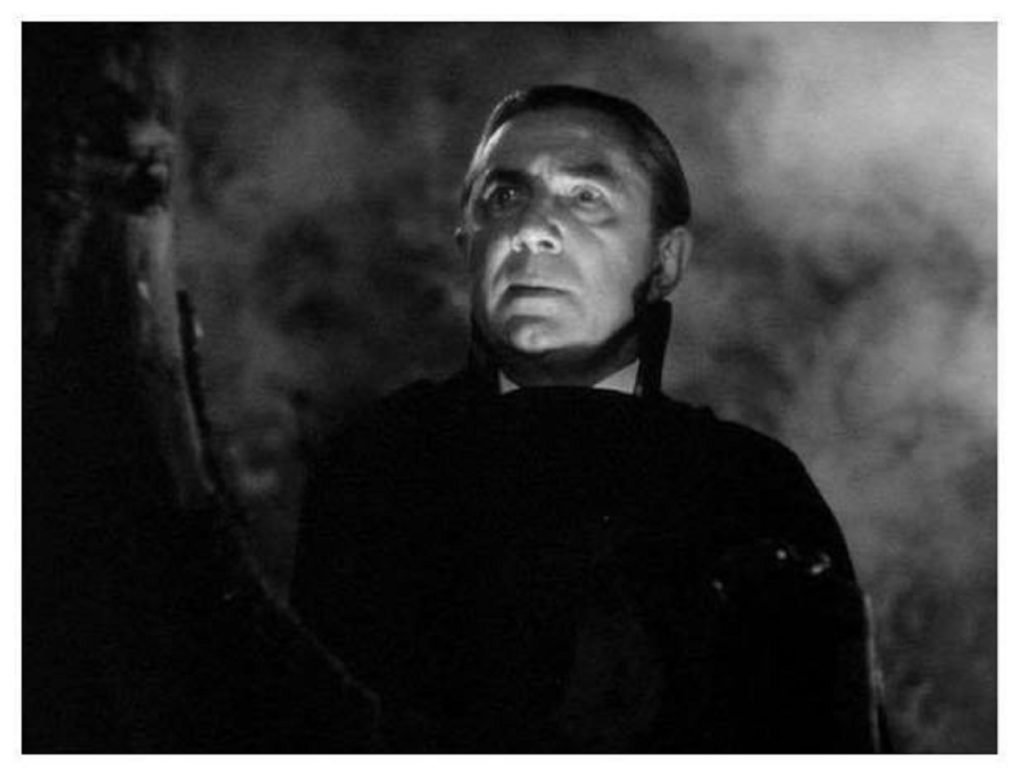
Thrillers from the Vault abruptly veers away from Boris Karloff and his Frankenstein-evoking “mad doctor” movies to showcase that other major Universal monster icon, Bela Lugosi, with 1943’s The Return of the Vampire. As the title suggests, this film sees Lugosi once again adorned with his famous black cape and fangs. Strictly speaking, he isn’t playing Dracula (due to copyright issues regarding the Tod Browning film), although he is basically playing Dracula. Though his character is called Armand Tesla for this resurrection of sorts, it is the only other time the actor would resume the role so closely in a non-comedic context. It really is great to see Lugosi back at it and giving it his all. He bites off plenty of screen time, to boot.
Although most of The Return of the Vampire is set in modern-day London (meaning, during World War II; meaning, air raids and shelling were the norm), it nevertheless includes some surprisingly stunning gothic visuals. The graveyard where Lugosi’s bloodsucker rises from the dead and where Andreas, his werewolf assistant prowls, is oozing with cool rolling fog, wrought iron fencing, and ominous headstones. It’s the kind of place where the sun never shines. While director Lew Landers (The Boogie Man Will Get You) does a primo job atmospherically on this film, he fumbles its narrative just enough to allow for confusion.
Oh, don’t worry- the fumbling isn’t terminal so much as it’s just slightly confounding. The story begins just after World War I, as a stoic professor realizes that a vampire, yes a vampire, is stalking London. He informs Lady Jane Ainsley (Frieda Inescort), who remains skeptical until the professor’s granddaughter is attacked by the creature. They go off and drive a metal spike through the sleeping vamp’s heart, ending him. Werewolf Andreas reverts to a grateful human.
But, soon after the girl is saved offscreen via a blood transfusion, the story jumps to World War II times. In a single line of dialogue, Lugosi- awakened as a result of the German shelling- informs us that the professor, whom we assumed was the film’s Van Helsing hero, has died. The vampire adopts an assumed identity in order to infiltrate Lady Jane’s son’s high society wedding… to the late professor’s once-bitten granddaughter. And what of poor Andreas amid all of this?
The Return of the Vampire, despite minor missteps, is a very satisfying romp for classic horror fans. The production value on display is genuinely impressive, up to the levels of Universal’s beloved efforts. The print utilized here is, for the most part, quite nice, albeit with a few instances of light vertical scratch marks. This title definitely could’ve used an audio commentary (The Boogie Man Will Get You got one, but not this??), but alas, there isn’t one.
Five
DIRECTED BY ARCH OBOLER/1951
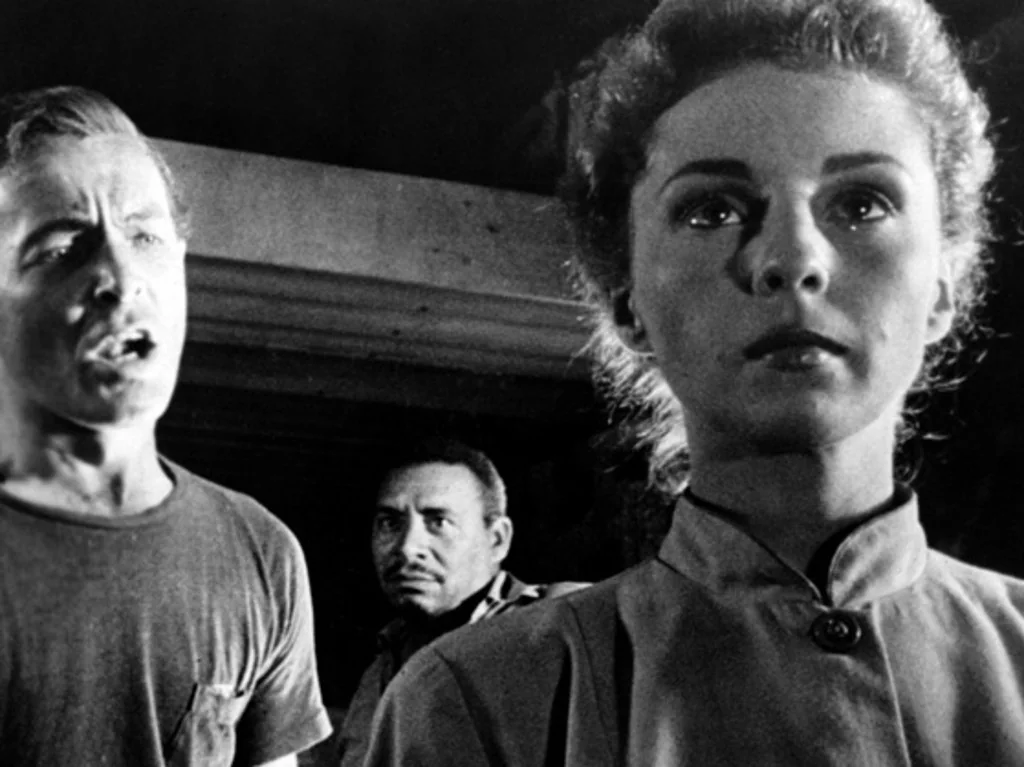
Much like its sister set, Sci-fi from the Vault, Thrillers from the Vault closes out with a curveball. The arc of the curve, however, couldn’t be more different. Whereas the otherwise serious Sci-fi set opted to go out on with the Lou Costello solo vehicle The 30 Foot Bride of Candy Rock, Thrillers jumps ahead to the next decade, landing squarely in the midst of some incredibly dire concerns.
Written, directed, and produced by radio drama pioneer Arch Oboler, 1951’s Five is said to be the first post-apocalyptic film ever made. From its very opening seconds- loud mushroom clouds blasting everything and everywhere- we know that we’ve turned a harsh corner into tense, real-world terror. And just like that, the quandaries of Boris Karloff and Bela Lugosi feel like remnants of an appealingly naive past.
While Oboler might not get the science of nuclear winter and mass destruction correct, Five nonetheless pulls no punches in terms of its back-to-basics survival scenario. Susan Douglas is effectively the lead, playing the quiet and quite pregnant Roseanne Rogers. Delirious and traumatized when we first see her, she staggers back to her beautiful hilltop home (a Frank Lloyd Wright design owned by Oboler himself) only to find it occupied by Michael (William Phipps), a rugged stranger and the first other living human she’s seen since detonation. Soon enough, they are joined by three other survivors…
Besides being a sad and sparse film that dares to address atomic annihilation, Five latched onto a jeep-load of baseline human behaviors that are rationally left in the “before times”, but plague the survivors nonetheless. Among them are Romero-esque flairs of selfishness, racism, and the inability to reconcile with the radically altered world. While the major cities are thought by some to be treasure troves of food and supplies there for the taking, they are also ground zero pockets of deadly radiation. Are our eventual group of five survivors immune? Why do they live while everyone else has been reduced to bones? (Lots of skeletons in this movie).
All they can do is move forward, though one of Five’s great grace notes is a moment when an electric generator is finally fired up, allowing recorded music to be played for the first time. This idea is used by director Matt Reeves in his own post-apocalyptic survivor story, Dawn of the Planet of the Apes (2014). In that film, the fact that the striking up of “The Weight” by The Band is the first thing anyone does once power is available is the film’s finest moment. In Five, the very similar bit (though with a classical record instead) is just another melancholy moment in a litany of such moments. The weight is absolutely, undeniably throughout.
Beautifully filmed in an exquisite location, Five radiates a fatalistic maturity that one typically doesn’t associate with the early 1950s. At the same time, various quotations of scripture and even a full recitation of a poem based on the creation story in Genesis come about. Oboler seems to have one foot planted in brutal, uncontrollable possibilities of the time and the other planted in a faith that tells of how God created the world, and humankind was created to care for it. Even some of these characters are able to derive hope from that.
It’s really too bad that this Blu-ray transfer of Five looks pretty lousy. Portions of the movie appear as though they’re taking place behind a dirty window, and picture noise is present throughout the entire ninety-one-minute running time. It’s also too bad that this film has no bonus features. According to the silkscreen printing on the disc itself, there’s supposed to be a commentary with Tom Weaver and Larry Blamire, but it ain’t there. While I’m not sure how Weaver’s typical lighthearted approach would pair with Five, the film definitely offers plenty to dissect and discuss.
*****
On disc one, we find the thirty-six-minute documentary Madness and Mayhem: Horror in the 30s and 40s. Film historian and filmmaker C. Courtney Joyner delivers a thoroughly enlightening tour of 1930s and ‘40s horror/thrillers at Columbia Pictures, and their top draw, Boris Karloff. This very well-realized piece does just what such a featurette should: generate interest and enthusiasm for the films covered. And it’s not just films in this set that are spotlighted. Joyner spends several minutes talking up a pivotal film called Black Moon (1934) by director Roy William Neill, which isn’t included. While one does come away wanting to check out Black Moon, the inclusive approach is spot-on. Karloff’s unofficially labelled “Mad Doctor” wave of Columbia horror titles get their due extended focus.
One of the official online blurbs advertising this set promises “Old Hollywood in crisp high definition on Blu-ray – like you’ve never seen it before”. Well, actually…. Frankly, as good as this set is, Mill Creek ought to know better than to float a boast like that. It sounds like a line from twenty years ago intended to boost a format more than the movies themselves. Besides geriatrics who might pick this up on a whim at Menards, the Blu-ray collector’s market is the very crowd this set seems designed to appeal to. All those commentaries, that terrific documentary featurette, that slipcover…! But then, most said collectors will have seen Old Hollywood high-definition transfers that look at least as good as these do. We are familiar with Criterion, the Warner Archive, Kino Lorber, and so many other specialty labels that handle “Old Hollywood” titles. At its best, Thrillers from the Vault matches the quality one expects from those labels.
That quibble aside, Thrillers from the Vault is, in terms of image quality, thoroughly passable, if not truly better. The good aspects of this set pretty far outweigh the bad. And if that’s not a thrill for classic horror fans, I’ll hang it up right here.


